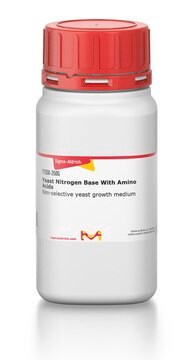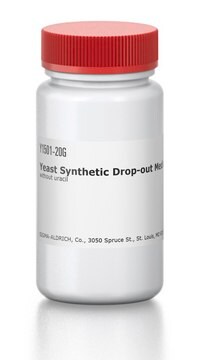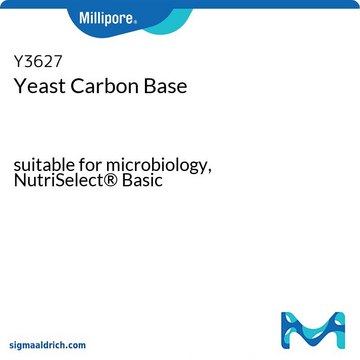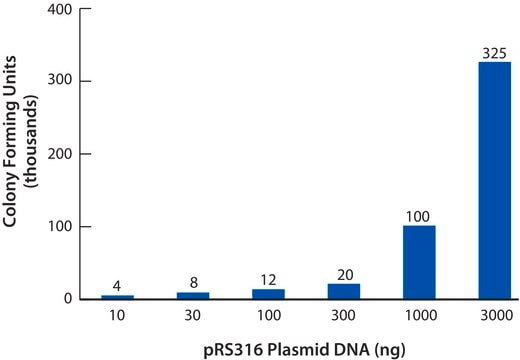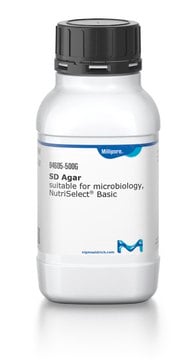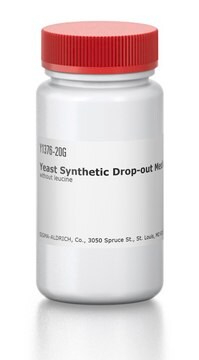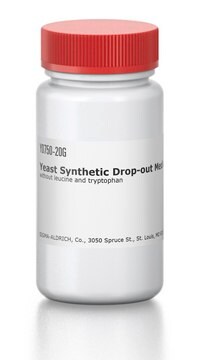Y1251
Yeast Nitrogen Base Without Amino Acids and Ammonium Sulfate
suitable for microbiology, NutriSelect® Basic
About This Item
Prodotti consigliati
Sterilità
non-sterile
Livello qualitativo
Forma fisica
powder
Confezionamento
poly bottle of 1 kg
poly bottle of 500 g
Produttore/marchio commerciale
NutriSelect® Basic
Solubilità
water: soluble 67 mg/mL
applicazioni
clinical testing
food and beverages
life science and biopharma
microbiology
Compatibilità
Candida spp.
Pichia spp.
Saccharomyces spp.
Zygosaccharomyces spp.
molds
yeasts
Descrizione generale
Applicazioni
Componenti
Biotin, 2 μg/L
Calcium pantothenate, 400 μg/L
Folic acid, 2 μg/L
Niacin, 400 μg/L
p-Aminobenzoic acid, 200 μg/L
Pyridoxine HCl, 400 μg/L
Riboflavin, 200 μg/L
Thiamine HCl, 400 μg/L
Inositol, 2 mg/L
Boric acid, 500 μg/L
Copper sulfate, 40 μg/L
Potassium iodide, 100 μg/L
Ferric chloride, 200 μg/L
Manganese sulfate, 400 μg/L
Sodium molybdate, 200 μg/L
Zinc sulfate, 400 μg/L
Potassium phosphate monobasic, 1 g/L
Magnesium sulfate, 0.5 g/L
Sodium chloride, 0.1 g/L
Calcium chloride, 0.1 g/L
Nota sulla preparazione
- Prepare a 10× stock solution by suspending 1.7 g of yeast nitrogen base without amino acids and ammonium sulfate in 100 ml of cold distilled water. Include desired nitrogen and carbon sources.
- Warm if necessary to solubilize and sterilize by filtration.
- Store 10× stock solution at 2-8°C. To use, dilute 1:10 with sterile distilled water under aspetic conditions.
Nota a piè di pagina
The designations basic, plus, or prime are added to indicate the quality control level, from basic quality control to standard QC plus to prime for full regulatory compliance.
Note legali
Solo come componenti del kit
- KH2PO4 1 g/L
- MgSO4 .5 g/L
- NaCl .1 g/L
- CaCl2 .1 g/L
- Inositol 2 mg/L
Codice della classe di stoccaggio
11 - Combustible Solids
Classe di pericolosità dell'acqua (WGK)
WGK 3
Punto d’infiammabilità (°F)
Not applicable
Punto d’infiammabilità (°C)
Not applicable
Dispositivi di protezione individuale
Eyeshields, Gloves, type N95 (US)
Certificati d'analisi (COA)
Cerca il Certificati d'analisi (COA) digitando il numero di lotto/batch corrispondente. I numeri di lotto o di batch sono stampati sull'etichetta dei prodotti dopo la parola ‘Lotto’ o ‘Batch’.
Possiedi già questo prodotto?
I documenti relativi ai prodotti acquistati recentemente sono disponibili nell’Archivio dei documenti.
I clienti hanno visto anche
Articoli
Traditional methods are based morphology, staining methods, enzyme reactions (metabolism) and diverse media.
Il team dei nostri ricercatori vanta grande esperienza in tutte le aree della ricerca quali Life Science, scienza dei materiali, sintesi chimica, cromatografia, discipline analitiche, ecc..
Contatta l'Assistenza Tecnica.
